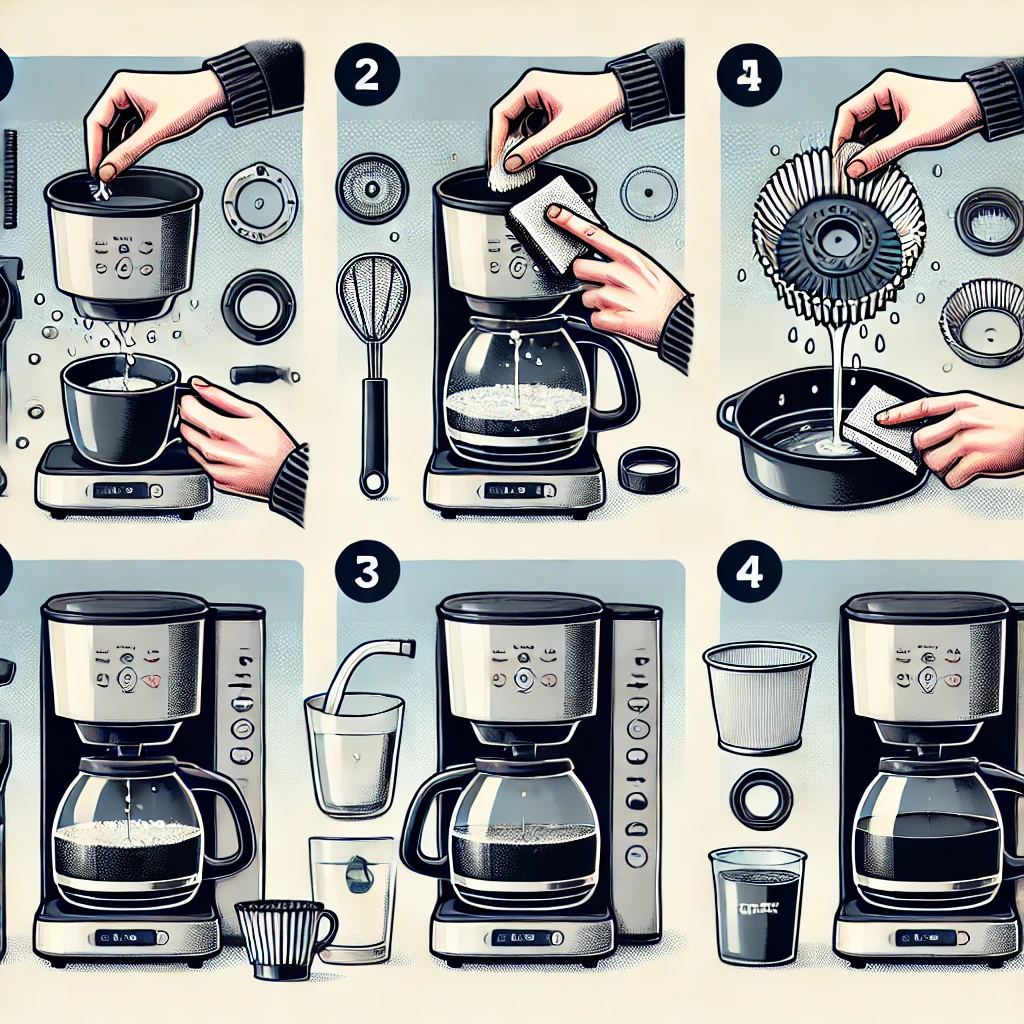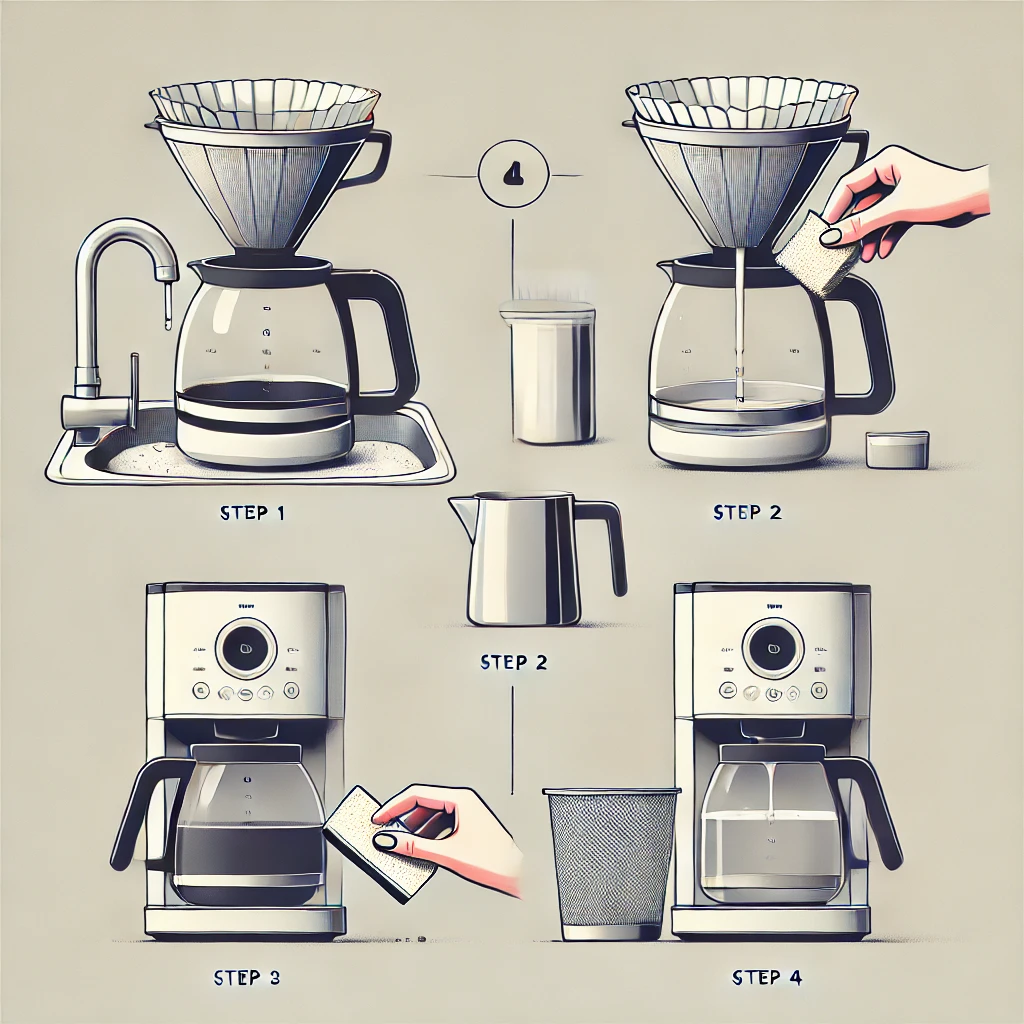Coffee lovers know that the key to a great cup of coffee lies not only in the quality of the beans but also in the cleanliness of the coffee maker. A dirty drip coffee maker can ruin even the best coffee beans, leaving you with a bitter, off-tasting brew. Over time, mineral deposits from water, coffee oils, and mold can build up inside your machine, affecting both the flavor of your coffee and the performance of the machine.
That’s why it’s crucial to know how to clean a drip coffee maker properly. In this comprehensive guide, we’ll walk you through the step-by-step process to ensure your coffee maker remains in peak condition, delivering delicious coffee every time.
Why Is It Important to Clean a Drip Coffee Maker?
Before we delve into the cleaning process, let’s discuss why it’s so important to keep your coffee maker clean. The answer lies in the potential problems that can arise when a drip coffee maker is neglected.
Mineral Build-Up
If you use tap water in your coffee maker, minerals such as calcium and magnesium can accumulate over time, particularly in areas with hard water. This build-up can clog the internal components of your coffee maker, slowing down the brewing process and leading to inconsistent brewing temperatures. The result? A pot of coffee that doesn’t taste quite right. Descaling your coffee maker regularly will help prevent this issue.
Coffee Oils
Every time you brew coffee, oils from the coffee grounds are left behind in your coffee maker. These oils can become rancid over time if not cleaned, leading to unpleasant, bitter flavors in your coffee. Additionally, these oils can stain the carafe and other parts of the coffee maker, making it look dirty and less appealing.
Mold and Bacteria
The warm, moist environment inside a coffee maker is an ideal breeding ground for mold and bacteria. If the coffee maker is not cleaned regularly, these can grow in the water reservoir, carafe, and filter basket, posing health risks and affecting the taste of your coffee.
How Often Should You Clean a Drip Coffee Maker?
The frequency with which you should clean your drip coffee maker depends on how often you use it. However, as a general guideline:
- Daily: Rinse the coffee pot and wash the filter basket with warm, soapy water.
- Weekly: Give your coffee maker a more thorough cleaning by washing all removable parts.
- Monthly: Descale the machine to remove any mineral deposits and thoroughly clean all components.
Step-by-Step Guide: How Do You Clean a Drip Coffee Maker?
Now that you understand the importance of regular cleaning, let’s get into the detailed steps of how to clean a drip coffee maker effectively.

Step 1: Gather Your Cleaning Supplies
To clean your drip coffee maker, you’ll need the following items:
- White vinegar
- Water
- Dish soap
- A clean sponge or dishcloth
- A soft brush or toothbrush (to scrub hard-to-reach areas)
- Paper filters (if your machine uses them)
Step 2: Empty and Disassemble the Coffee Maker
Start by emptying the carafe of any remaining coffee or water. Then, unplug the coffee maker and remove all detachable parts, including the carafe, filter basket, and any other components that can be removed. Disassembling the machine makes it easier to clean each part thoroughly.
Step 3: Clean the Removable Parts
Once disassembled, wash the removable parts in warm, soapy water. Use a sponge or dishcloth to scrub away any coffee stains, oils, and residues. For stubborn stains or hard-to-reach areas, a soft brush or toothbrush can be very effective. Rinse everything thoroughly to remove any soap residue, then set the parts aside to air dry.
Step 4: Descale the Coffee Maker
Over time, mineral deposits from water can build up inside your coffee maker, affecting its performance. Descaling is the process of removing these deposits. Here’s how to do it:
- Prepare a descaling solution: Fill the water reservoir with a solution of equal parts white vinegar and water. This mixture will help dissolve the mineral deposits inside the machine.
- Start the brew cycle: Place a paper filter in the filter basket (if applicable) and start the brew cycle. Let the coffee maker run until it’s about halfway through the cycle, then turn it off.
- Let it soak: Allow the vinegar solution to sit in the coffee maker for 30 minutes to an hour. This soaking time helps to break down the mineral build-up inside the machine.
- Complete the cycle: After soaking, turn the coffee maker back on and allow it to complete the brew cycle. Once the cycle is finished, discard the vinegar solution and the paper filter.
Step 5: Rinse the Coffee Maker
To remove any lingering vinegar taste or smell, it’s essential to rinse the coffee maker thoroughly. Fill the water reservoir with clean water and run two or three brew cycles with just water, using fresh water for each cycle. This will flush out any remaining vinegar and ensure that your next pot of coffee is free from any off-flavors.
Step 6: Wipe Down the Exterior
While the coffee maker is running its rinse cycles, use a damp cloth to wipe down the exterior of the machine. Pay close attention to buttons, knobs, and any other areas where coffee or water may have splashed. Keeping the exterior clean not only maintains the appearance of your coffee maker but also prevents the build-up of dirt and grime that could affect its operation.
Step 7: Reassemble the Coffee Maker
Once all the parts are clean and dry, reassemble your coffee maker. Ensure that everything is securely in place and ready for your next brew. A well-maintained coffee maker not only looks good but also performs better, providing you with a delicious cup of coffee every time.
Read more: How to Use a Keurig Mini: A Comprehensive Guide
Additional Tips for Maintaining Your Drip Coffee Maker
Beyond regular cleaning, there are a few extra steps you can take to ensure your coffee maker stays in top condition.

Use Filtered Water
Using filtered water instead of tap water can significantly reduce the amount of mineral build-up in your coffee maker. This not only improves the taste of your coffee but also extends the life of your machine by preventing clogging and scale formation.
Replace Coffee Filters Regularly
If your drip coffee maker uses paper filters, be sure to replace them after each use. Reusing filters can lead to the growth of mold and bacteria, which can negatively impact the taste of your coffee and pose health risks.
Store Your Coffee Maker Properly
If you don’t plan on using your coffee maker for an extended period, make sure to clean it thoroughly before storing it. Empty the water reservoir, clean all parts, and store the machine in a cool, dry place. This will prevent mold and mildew from forming inside the machine while it’s not in use.
Schedule Regular Deep Cleanings
Even with regular maintenance, it’s a good idea to schedule deep cleanings every few months, especially if you use your coffee maker frequently. This deep cleaning process should include descaling and a thorough cleaning of all removable parts to ensure your machine remains in top working condition.
Conclusion: The Key to Great Coffee Is a Clean Coffee Maker
In summary, knowing how to clean a drip coffee maker is essential for every coffee lover who wants to enjoy the best possible brew. Regular cleaning prevents the build-up of minerals, coffee oils, and mold, all of which can affect the taste and safety of your coffee. By following the steps outlined in this guide, you can keep your drip coffee maker in excellent condition, ensuring that every cup you brew is fresh, flavorful, and satisfying.
Remember, the quality of your coffee depends not only on the beans you use but also on the cleanliness of your coffee maker. So, make cleaning a regular part of your coffee routine, and enjoy the rich, delicious flavor of freshly brewed coffee every day.

I’m Kara Chavez, and I love coffee. I like to create some of the best coffees around – espressos, lattes, macchiatos . I strive for perfection in my coffee-making skills, and I take great pride in providing a delicious cup of joe to my customers.
I’ve been working in the coffee industry for years now, and I know everything there is to know about making a perfect cup of coffee. My passion for coffee shines through in every cup that I make, and I hope that you’ll stop by soon so that I can share my love of coffee with you!

